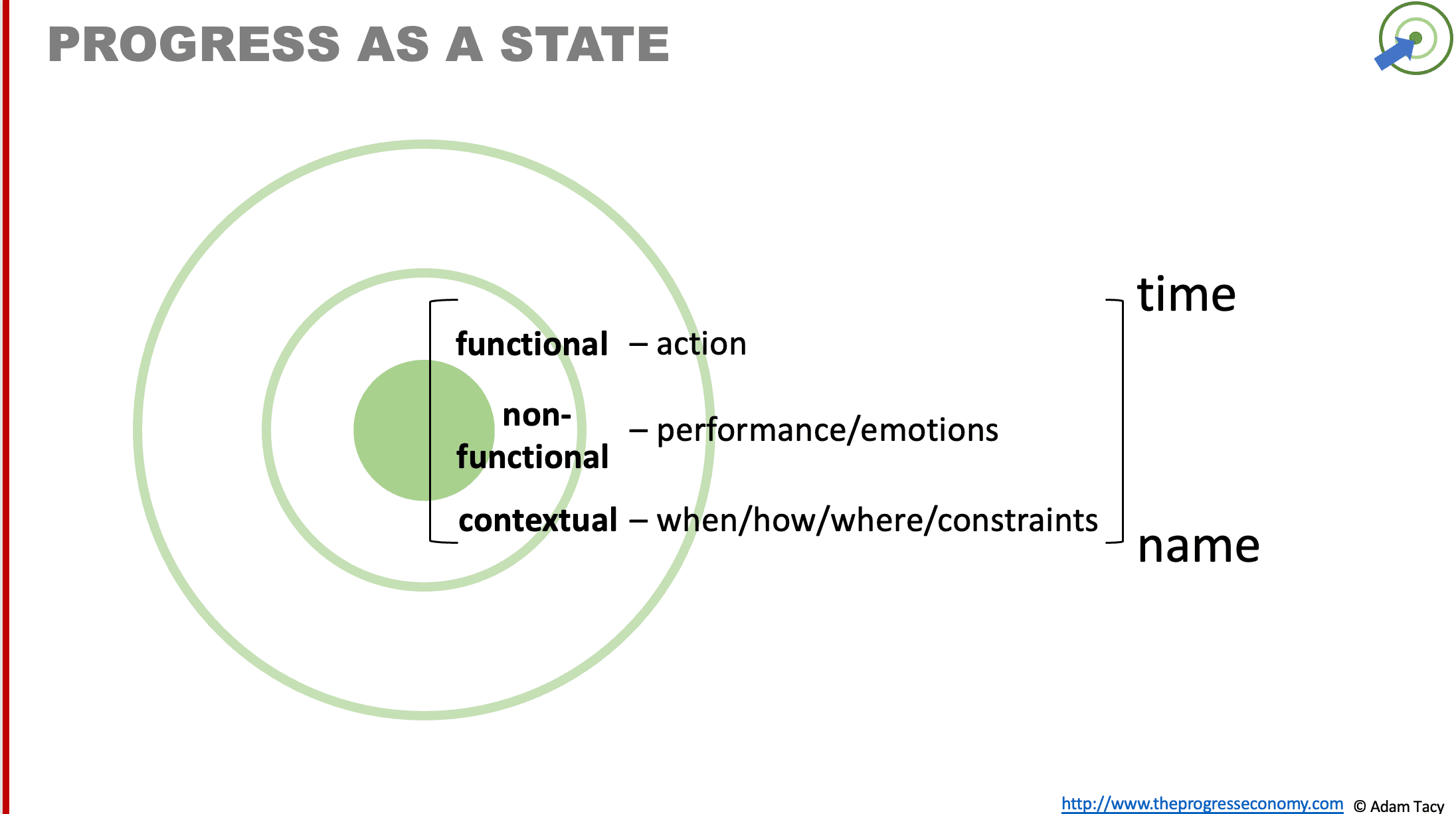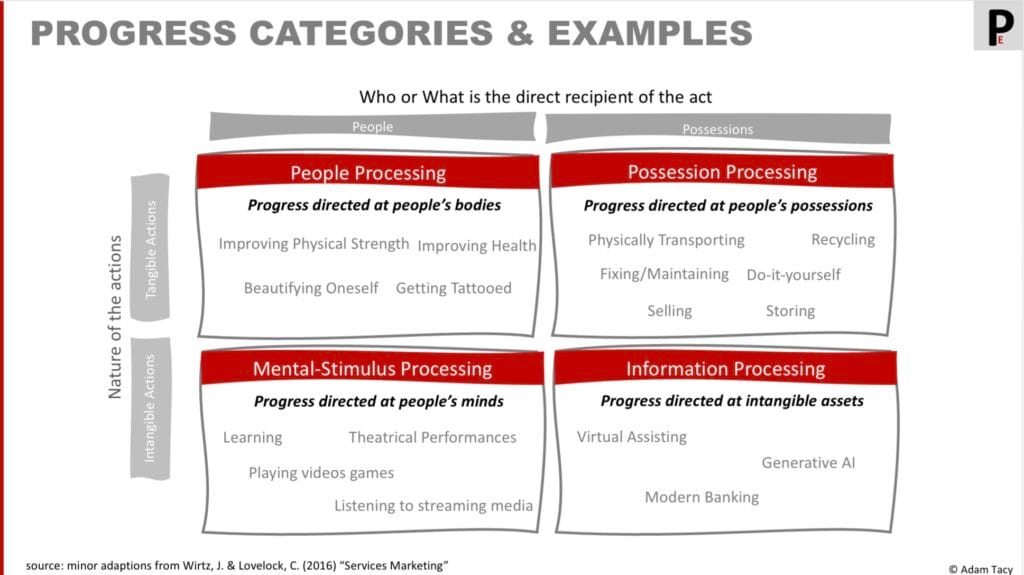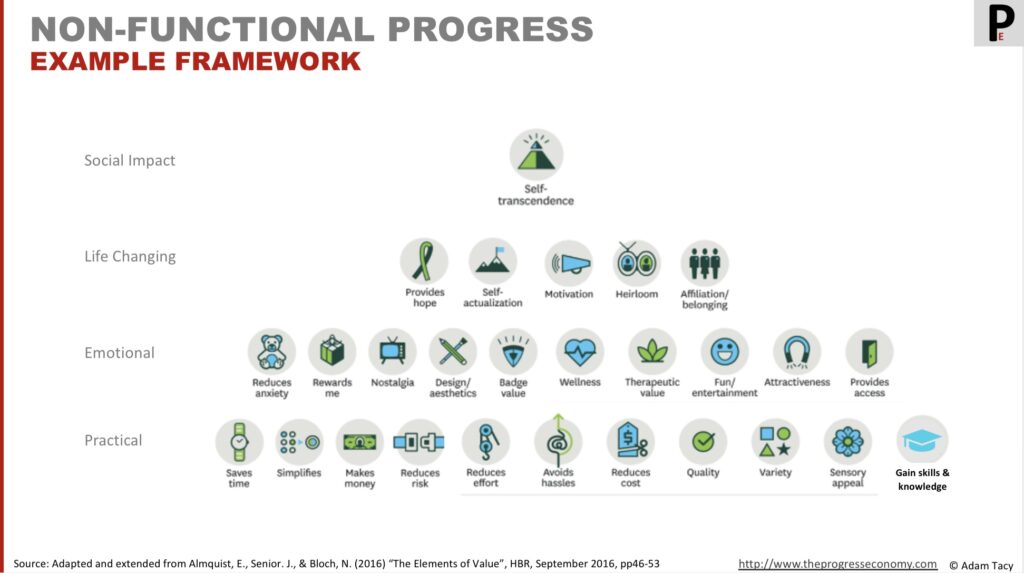Progress has three, equally important, dimensions – functional, non-functional and contextual. Not understanding one or more will sink your innovation, sales, and growth.
What we’re thinking
Progress is a state – a snapshot comprising three elements, namely:
- functional progress: the action
- non-functional progress: performance, emotions, and feelings.
- contextual progress: the constraints, when, where and how
Identifying and understanding all three elements is critical for understanding seeker’s desires, making progress, progress propositions, value, and pursuing successful innovation.
Failing to do so may lead to the next super-market self checkouts…
Progress as a state
Progress as a state is a foundational concept in the Progress Economy. It frames how both Seekers and Helpers understand, and measure, progress journeys.
We’ll even name several important states. Some are waypoints on the journey, such as the desired state a seeker wants to reach: progress sought. Others are states resulting from a Seeker’s judgement – Seekers continuously assess what state they can realistically reach and how far they’ve progressed. Helpers, in turn, design offerings that aim to help Seekers reach their more desired state from specific starting points.
So what exactly defines a progress state?
progress state: a snapshot of progress comprising functional, non-functional and contextual elements.
A progress state is a snapshot comprising three essential dimensions:
- Functional progress
- Non-functional progress
- Contextual progress
All three are required to understand what progress truly means to a Seeker, and to design propositions that resonate.
Understanding a progress state
Let’s begin with a simple example of progress sought (the state a Seeker desires to reach):
- Functional – get to my office
- Non-functional – as quickly as possible
- Contextual – it’s rush hour and the office is 30km away
Functional progress tends to be the most explicit and easiest to articulate. But once you factor in non-functional dimensions – such as safety, ease, or speed – you begin to uncover deeper motivations. Context then introduces real-world constraints that further define what meaningful progress looks like.
Let’s explore why these layers improve our understanding of progress through a series of iterations.
Improving understanding of progress
Consider the three examples of progress sought in the table below:
| progress dimensions | progress journey description | |
|---|---|---|
| basic | Just functional | Get to my office from home |
| better | Functional and contextual | Get to my office; it’s 30km from my home and I’ll travel during rush hour |
| best | Functional, non-functional and contextual | Get to my office as quickly as possible; it’s 30km from my home and I’ll travel during rush hour |
These toy examples illustrate how incorporating non-functional and contextual elements improves the usability of progress insights—particularly when crafting innovation.
Basic Progress
A purely functional view—“get to my office”—opens up a vast, unfocused solution space. Walking, driving, ride-share, public transport, even teleportation or drone taxis all qualify. But with no non-functional or contextual guidance, it’s unclear which of these would actually appeal to real Seekers.
Better Progress
Now add context. “My office is 30km away and it’s rush hour.” Walking and cycling may drop away for many Seekers. The context might tilt decisions in favor of public transport over driving—at least at first glance.
Note: writing “Get to my office 30km away” would bake the constraint into the functional dimension. That’s not helpful. Functional should remain a pure expression of action. Constraints belong to context.
Best Progress
Adding non-functional detail—“as directly as possible”—provides further clarity. Suppose the nearest train station requires two bus changes. Suddenly, public transport becomes less attractive despite rush hour congestion. Driving might emerge as the more viable option. Now you’re not just segmenting users—you’re understanding them.
Why do so many innovation efforts fail? Because they often miss these layers. They skip the nuance. They don’t uncover what really shapes choice.
Now let’s explore each dimension in more depth.
Functional progress
Functional progress captures the action a Seeker wants to perform—learn a language, travel, fix something, entertain themselves.
functional progress: the action element of progress
You uncover it by simply asking: “What are you functionally trying to do?” This is where Jobs-to-be-Done thinking overlaps with the Progress Economy.
But we need to be careful and remember that this is a state, not an action. So after asking the question it needs to be captured as a state. For example, learning Mandaring Chinese is an action, it needs to be turned into a state such as “able to speak Mandarin Chinese at HSK 5 level” (for the more desired state) or “unable to speak Mandaring Chinese” (for the starting state)
We can also borrow from Lovelock & Wirtz’s service framework, originally created to classify services, and adapt it to understand functional progress. Their framework categorises service into four distinct processing areas: people, possessions, mental stimuli, and information
With slight adjustments to the terminology, we arrive at the following:
| processing category | description |
|---|---|
| people | progress related to individuals’ bodies, such as achieving physical fitness, enhancing appearance, improving health (medical services), and more. |
| possession | progress concerning individuals’ possessions, encompassing activities like transporting, recycling, storing, selling, renting, maintaining, fixing, and DIY tasks. |
| mental stimulus | progress involving individuals’ minds, which includes teaching, training, attending theatrical performances, and engaging with content like streaming services, podcasts, and Netflix. |
| information | progress tied to intangible resources, such as word processing, using virtual assistants, leveraging generative AI, and banking services. |
This framework helps systematize the identification of functional progress across sectors and industries. Once you’ve identified the processing category, you can explore analogous services, even outside your industry, to spark innovation.
However, as we’ve seen, functional progress on does not give us the full picture, we need non-functional and contextual progress too.
Non-functional progress
Non-functional progress captures the performance and emotional dimensions – how progress should feel, how easy or fast it should be, and what it should accomplish emotionally.
non-functional progress: performance, emotions, feelings, etc, element of progress.
Identifying non-functional progress can be challenging, but is important to capture. Often it requires an interrogative approach as they are not easily observable.
Almquist et al.’s The Elements of Value offers a practical starting point. We adapt their hierarchy by relabelling the “functional” layer to “practical” and removing overlaps with functional progress, such as “informs” or “connects.”
It covers practical aspect such as saving time (a resource that is often in short supply) and reducing risks and effort required from seeker (which hints at a need for relieving propositions). As we climb the hierarchy we find layers of emotions, life changing and social impact.
The paradox of non-functional
Adam Smith wrote in Wealth of Nations:
It is the maxim of every prudent master of a family, never to attempt to make at home what it will cost him more to make than to buy…
Adam Smith () “The Wealth Of Nations”, Book IV Chapter II, pp. 456-7, paras. 11-12.
Economically sound? Perhaps. But the Progress Economy, helps us understand that that logic doesn’t always hold. People make their own bread, brew beer, sew clothes – not because it’s cheaper, but because it delivers emotional satisfaction. That’s non-functional progress. That’s meaning.
Whilst we’ll later see that there’s a shift towards relieving propositions (those that meet and surpass Smith’s view), there are also Seekers that prefer enabling propositions – one’s the allow them to make progress themselves.
Impact of misidentifying non-functional progress
Overlooking the non-functional dimension often results in misguided innovation – and frustrated progress Seekers. Take self-checkouts at supermarkets. Ostensibly, they were introduced to reduce wait times and help time-pressed shoppers. But are they truly aligned with customers’ progress sought? Or is it a more transparent cost saving measure by the supermarkets.
In reality, many users report that self-checkouts are not faster. The task merely occupies their attention. As one study notes:
Despite what grocery stores and kiosk manufacturers claim, research shows self-checkouts aren’t actually any faster than a regular checkout line, Andrews says. “It only feels like it because your time is occupied doing tasks, rather than paying attention to each second ticking away.”
The Guardian (2022) “Unexpected item’: how self-checkouts failed to live up to their promise
quoting Andrews C.K. (2020) “The Overworked Consumer: Self-Checkouts, Supermarkets, and the Do-It-Yourself Economy”, Lexington Books.
From a progress perspective, these kiosks increase cognitive load, heighten risk (e.g., scanning errors), and amplify anxiety (e.g., unexpected item alerts, surveillance). They rarely simplify, ease effort, or deliver emotional satisfaction for the majority of Seekers. Although, there are Seekers that prefer them – if you’re in a rush and have a small number of items.
By understanding Seeker’s non-functional progress better, Supermarkets could have been successful in implementing self-checkouts. Perhaps a smaller scale rollout for those whose progress they support rather than the mass conversions we’ve seen. Instead, we’re left with large areas of supermarkets empty, longer queues in the manned checkouts; and Seeker resistance.
No wonder some chains are now removing them.
Last week, due to continuing customer demand, the north of England supermarket chain announced its plan to replace self-service tills with human cashiers. It turns out that its customers – like many of us – prefer the problem-solving capacity of a human mind to being bossed around by a machine.
The Guardian, November 2023
And this is not just because of non-functional progress. Context is also important.
Contextual progress
As Christensen says about jobs-to-be-dopne (which we can link to progress):
A job can only be defined – and a successful solution created – relative to the specific context in which it arises
Christensen, C (2016) “Competing against luck”
In the progress economy we capture this as contextual progress. It shows the when, how, and where progress occurs and often informs us of other constraints.
contextual progress: information related to when/how/where the progress happens (can often be constraints).
Let’s revisit the self-checkout at supermarkets (and more). On a wet Wednesday, with two items in hand, and in a rush, it likely makes sense to a number of Seekers. But during a big weekly shop, it makes less sense. Context shapes success. Ask yourself what proportion of Seekers do supermarkets have that are in both contexts?
Context also highlights constraints. Say your progress is to travel 100km. Not having a driving license puts a constraint on solutions that will appeal to you.
There is a peculiarity about contextual progress. We don’t expect it to change over time during progress (see progress as a verb).
Segmentation on progress state
A powerful use of progress as a state is in segmentation of markets (and therefore of progress propositions, sales, and innovation activities). Look at this damming quote from Christensen and others:
…the prevailing methods of segmentation that budding managers learn in business schools and then practice in the marketing departments of good companies are actually a key reason that new product innovation has become a gamble in which the odds of winning are horrifyingly low.
Christensen, C. M., Cook, S., Hall, T. (2005) “Marketing Malpractice” Harvard Business Review
They go on to develop the view that segmenting on demographics, or product features, is hardly useful. Instead, they propose segmenting on the job to be done. That translates for the progress economy to segmenting on the three dimensions of progress state. If supermarkets had done that, then they would have found less Seekers in the “quick, small number of items” segment than in the “weekly shop, risk adverse” segment – leading to less manned checkout replacement.
Since the progress economy looks at both a Seeker’s starting point, desired end point, and how they get between the two, segmentation on progress provides a rich matrix looking for solutions.
Additionally, we can explore elements of the three progress dimensions using Blue Ocean Strategy‘s strategy canvas. Looking to add, remove, increase or reduce elements in market offerings. For example, can we simplify today’s existing propositions, or increase the time-savings possible; maybe we can reduce anxiety; or perhaps we reduce time-savings whilst increasing self-actualisation.
Why this matters
Most innovation efforts falter not due to a lack of creativity, but from a poor understanding of what customers are truly trying to achieve. Too often, organizations latch onto the functional side – what people are doing – while ignoring how they want to, for example, feel and the context they’re operating in.
The Progress Economy introduces a more complete model: progress as a state defined by three intertwined dimensions: functional, non-functional, and contextual. This triad is essential. Get just one wrong and you risk designing solutions that miss the mark, even if the feature set seems flawless.
Consider the supermarket self-checkout. Functionally sound. Contextually plausible. But emotionally misaligned. The result? Customer frustration, brand erosion, and backpedaling.
By contrast, when you integrate all three progress dimensions, you unlock sharper segmentation, stronger value propositions, and more resonant innovations. You start to see customers not just as users, but as humans navigating trade-offs and aspirations within specific constraints.
This isn’t academic. It’s strategic. Understanding progress in all its dimensions gives you a more reliable engine for innovation, customer-centric growth, and competitive differentiation.



Let’s progress together through discussion…